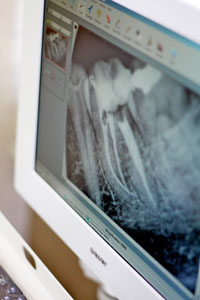FAQs
 What is endodontics?
What is endodontics?
Endodontics is a branch of dentistry recognized by the American Dental Association involving treatment of the pulp (root canal) and surrounding tissues of the tooth. When you look at your tooth in the mirror, what you see is the crown. The rest of the tooth, the portion hidden beneath the gum line, is called the root. The outer portion of the root is made up of hard tissue and the inside channel or "root canal" contains a pulp of soft tissue, blood vessels and nerves. The pulp can become damaged due to previous necessary dental procedures or trauma. Bacteria can be introduced into the pulp as a result of tooth decay, periodontal disease, tooth fracture or other problems and can severely damage the pulp. When that happens, an endodontic specialist removes the diseased pulp to save the tooth and prevent further infection and inflammation. After successful endodontic treatment, the tooth continues to perform normally in the majority of cases.
I'm worried about x-rays. Should I be?
While x-rays will be necessary during your endodontic treatment, we use an advanced non-film computerized system, called digital radiography, that produces radiation levels up to 90 percent lower than those of already low dose conventional dental x-ray machinery. These digital images can be optimized, archived, printed and sent to cotherapists via e-mail. For more information contact Schick Technologies, Inc.
What about infection?
Again, there's no need for concern. We adhere to rigorous standards of infection control advocated by OSHA, the Centers for Disease Control and the American Dental Association. We utilize autoclave sterilization and barrier techniques to eliminate the risk of office induced infection.
 What new technologies are being used?
What new technologies are being used?
-Magnification & fiber optic illumination are helpful in aiding the doctor to see tiny details inside and outside your tooth.
-Digital radiography allow us to view images on a screen and enhance their quality.
-Nickel titanium rotary instruments better prepare curved canals.
-DOM (Dental Operating Microscope) for visualization of tooth anatomy.
What happens after treatment?
When your root canal therapy has been completed, a record of your treatment will be sent to your restorative dentist. You should contact his or her office for a follow-up restoration within a few weeks of completion at our office. Your restorative dentist will decide on what type of restoration is necessary to protect your tooth. It is rare for endodontic patients to experience complications after routine endodontic treatment or microsurgery. You will be asked to refrain from chewing on the endodontically treated tooth until after your dentist is able to restore it to function. If a problem does occur, however, we are available to help.

